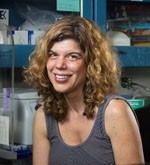
Resting neural stem cells (nuclei shown in blue) accumulate large protein aggregates (pink) in and around storage compartments called lysosomes (green).
Xiaoai Zhao
Young, resting neural stem cells in the brains of mice store large clumps of proteins in specialized cellular trash compartments known as lysosomes, researchers at the Stanford University School of Medicine have found.
As the cells age, they become less proficient at disposing of these protein aggregates, and their ability to respond readily to “make new neurons” signals wanes. Restoring the ability of the lysosomes to function normally rejuvenates the cells’ ability to activate, the researchers found.
The discovery of the aggregates in young stem cells was unexpected, in part because similar aggregates are associated with the development of neurodegenerative diseases, such as Alzheimer’s. It also highlights the importance of maintaining precise control over the protein production and disposal process throughout the life and activation status of neural stem cells.
“We were surprised by this finding because resting, or quiescent, neural stem cells have been thought to be a really pristine cell type just waiting for activation,” said Anne Brunet, PhD, professor of genetics. “But now we’ve learned they have more protein aggregates than activated stem cells, and that these aggregates continue to accumulate as the cells age. If we remove these aggregates, we can improve the cells’ ability to activate and make new neurons. So if one were able to restore this protein-processing function, it could be very important to bringing older, more dormant neural stem cells ‘back to life.’”
A paper describing the research was published March 15 in Science. Brunet, an associate director of Stanford’s Paul F. Glenn Center for the Biology of Aging, is the senior author. Postdoctoral scholar Dena Leeman, PhD, is the lead author.
Resting versus active neural stem cells
The researchers began their studies by looking to see what difference there might be, if any, between the gene expression profiles of resting neural stem cells and those that had been activated in response to an outside signal to launch the process to make new neurons. They also compared how the cells changed as they aged.

Anne Brunet
Leeman isolated several populations of cells for study from the brains of both young and old mice, including resting neural stem cells, activated neural stem cells and the neural cell progenitors that arise from activated stem cells. She found that resting stem cells expressed many lysosome-associated genes, while activated stem cells expressed genes associated with a protein complex involved in protein destruction called a proteasome. Strict control of production and disposal allows cells to maintain the necessary protein inventory to carry out needed cellular functions.
When Leeman stained young resting and activated neural stem cells with a dye that binds to protein aggregates, she was surprised to find the resting stem cells stained more brightly, despite the fact that resting cells have a lower rate of protein production. Leeman also found that the young resting neural stem cells accumulated these protein aggregates in their large lysosomes relatively slowly compared with their activated counterparts.
“We were really struck by the differences between resting and activated stem cells in the expression of genes involved in protein quality control,” said Brunet. “The fact that these young, pristine resting stem cells accumulate protein aggregates makes us wonder whether they actually serve an important function, perhaps by serving as a source of nutrients or energy upon degradation.”
It’s almost as if these older cells lose the ability to store, or park, these aggregates.
Old resting stem cells, Leeman found, express fewer lysosome-associated genes and begin to accumulate even higher levels of protein aggregates.
“It’s almost as if these older cells lose the ability to store, or park, these aggregates,” said Brunet, who is also the Michele and Timothy Barakett Endowed Professor. “We found that artificially clearing them by either activating lysosomes in older cells or subjecting them to starvation conditions to limit their protein production actually restored the ability of these older resting stem cells to activate.”
The researchers plan to continue their studies to learn what types of proteins might be contributing to the aggregates, to better understand why activated neural stem cells appear to favor proteasomes over lysosomes and to determine how the regulation of protein aggregation becomes disrupted during aging.
‘Are they good or bad?’
“We’d like to know whether the aggregated proteins are the same in the young and old cells,” said Brunet. “What do they do? Are they good or bad? Are they storing factors important for activation? If so, can we help elderly resting stem cells activate more quickly by harnessing these factors? Their existence in young cells suggests they may be serving an important function.”
Other Stanford authors are former postdoctoral scholars Katja Hebestreit, PhD, and Ashley Webb, PhD; postdoctoral scholars Tyson Ruetz, PhD, Salah Mahmoudi, PhD, and Xiaoai Zhao, MD, PhD; graduate students Andrew McKay, Robin Yeo and Ben Dulken; former graduate student Elizabeth Pollina, PhD; laboratory manager Keerthana Devarajan; Thomas Rando, MD, PhD, professor of neurology and neurological sciences; and Judith Frydman, PhD, professor of genetics and of biology.
Brunet is a member of Stanford’s Cardiovascular Institute, Cancer Institute, Neurosciences Institute and Stanford Bio-X.
The research was supported by the National Institutes of Health (grants P01AG036695, F31AG043232 and T32GM7365), the National Science Foundation, the Glenn/American Federation for Aging Research, Stanford Bio-X, a National Defense Science and Engineering Graduate Fellowship and a Stanford cancer biology training grant.
Stanford’s Department of Genetics also supported the work.
http://med.stanford.edu/news/all-news/2018/03/clearing-clumps-of-protein-in-aging-neural-stem-cells-...


